|
|
Museums in Vienna - Visits
In Vienna, all kinds of museum lovers will be delighted. For all imaginable fields there is one or maybe the! museum worldwide existing in Vienna. Not only artworks, excavations or scientific achievements can be admired but also whole residences and working places of famous personalities of Vienna, as for example the one of Sigmund Freud or, of course, of the Viennese musicians Haydn, Beethoven or Schubert, only to mention a few. Nevertheless, one should calculate previously that per each visit of the museum there are approximately 10 euros to pay (state: atumn 2007). Most of the times, the obligatory fees for the wardrobe or the rucksack that oftenly has to be handed off, are not included in that. With the Vienna-card there is a discount of 1 euro in one or two museums, but anyhow, the museum fees during the city viewing in Vienna cost a pretty penny. Thus, Vienna surely belongs to the more expensive places for a holiday if one is not limited on walking through the city or viewing the churches. In the following tet I will describe a small choice of museums. Natural History Museum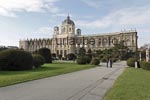
Although the museums are spread all over the city, the most significant ones are located centrally around the Hofburg of Vienna. Not far from the new Hofburg, there are both museum buildings of arts and ntural history that physically seem to be almost identical. Here, only both neo-rennaissance buildings and their arquitecture already have a museum character. In the middle of the mirror-invertedly positioned buildings, Maria Theresia enthrones on an oversozed monument. It is really impressive to let one's eyes travel over this gorgeous coulisse with the artfully cut bushes and dapper meadows. 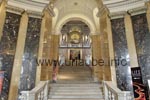

The natural history museum was not inaugurated until the yer 1889, but the origins of its collection of more than 20 million exhibits go back up to the year 1748, when Franz Stephan von Lothringen, husband of Maria Theresia, founded a natural produce cabinet. In the interior, one first gets to a fulminant foyer that leads one straight up over an imposing stairway to the upper floors. The atmosphere of the interior is gigantic. Only the view into the octagonal cuppola that etends over the café with the museum shop has not been shortened compared to many sacral domed structures. In the nearly 40 exhibition rooms there are exhibits that show the history of origin and development of all kinds of plants, animals or minerals. Not only children might get a spooky impression of the times passed long ago by the huge dinosaur skeletons. Also reptiles, birds or carnivores are lifelike. The abundant cabinets with any kind of smaller animals or stones seem a little antiquated, but for zoology or mineralogy a real delight. 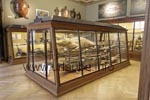
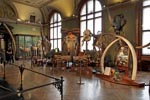
In the total of three exhibition floors one can spend several hours without getting bored. In the lower area there is one vivarium, in which one can see living reptiles and fishes, thereunder also living piranhas. In this rather small and for us not very interesting area, many visitors cavorted so that it got very tight. But in total we remind this museum as a real highlight that we would like to visit again some years later with our children. Beside the usual inventory, the exhibitions continuously change to certain topics. Art History MuseumUp to the middle of the 18th century, the art collections of Habsburg were spread in several small museums of Vienna. In order to get them collected under one roof and keep them in a respectively representative for the posterity, a central museum building was supposed to be built. On the ground that was originally planned as Emperor's forum by Gottfried Semper and Karl Freiherr von Hasenauer, from the year 1871, the construction works began for the two nearly identical buildings. In the interior of one of those museums there is so much to see that it is hardly possible to view both on one day. Although the sightseeings are really interesting and it is repeatedely excellent to see the original works of famous artists, at some time, one's perception is exhausted due to those masses. 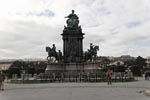
There are several collections in the interior: in the first floor, there is worldwide the fourth-biggest painting collection of its kind. Paintings of the whole of Europe of different eras and famous artists as Rembrandt, Dürer, Holbein, Tizian, Veronese, Tintoretto or Eyck, Rubens, van Dyck can be admired here. The collection of egyptian-oriental findings comprehends beside numerous clay pots, busts, statues, also ritual objects, reliefs and plates with inscripts. Also the collection of antiques contains a profile of the Greek, Helenistic, Etruscan and Roman Arts as also findings of the late antiquity and the early christendom. Another focus of this museum is the chamber of arts that, beside jewelry pieces and goldworks, there are also other objects of the daily life, as for example clocks or games. Also the coin cabinet contains with its approximately 700.000 exhibits, beside coins also medals, orders, and paper money. Museumsquartier - Area of Arts on 60.000m²The Museum quarter is one of the 10 biggest of its kind worldwide, after it has been reopened in the year 2001. On the whole area that etends over a surface of 60.000m², one finds a kind of quarter of its own. Despite of the total more than 20 museums, one repeatedely comes across to smaller courts and plazas with banks, several cafés or shops in which one can obtain some souvenirs or books. 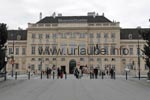
Coming from both museums for arts and natural history, we straight approached the museum quartier and saw ourselves suddenly displaced in a completely different world. Through the modern arquitecture, as for example the museum of modern arts or the Leopold museum, in conjunction with the recently adjioning buildings that were originally built by the Emperor's family, a very uncommon atmosphere is created that reflects the character of Vienna very well. Old meets new -on highest artistical level - without experiencing any feeling of disharmony.. All arrangements of the museum quarter of Vienna can be visited almost on a daily basis. Museum of Modern Arts - Donation Ludwig Wien in MQ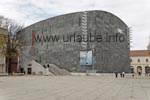
The museum of modern arts - donation Ludwig Wien, MUMOK, was reopened in the year 2001 and is the most eye catching building of the museum quarter ever since. The surface of approximately 4.500 m² offer space for the currently more thsn 7.000 exhibits. But modern and also contemporary arts are not only exhibited here, but also examinated under schientific aspects at the same time and their history of evolution transferred by numerous events and performances. The exhibits are not only limited to paintings but are also added by sculptures or video animations. Thus, the direction of style of the classic modern arts is represented by cubistic, futuristic, constructivistic, or surrealistic paintings, that are edded by contemporary artists with their artworks of Pop Art, Actionism of Vienna, the Concept Arts or the Fuxus. By this way, the exhibition gets a very special touch of performance arts. Leopold Museum in the Museumsquartier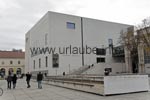
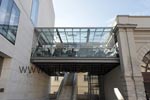
The building of the Ludwig Museum has an area of exhibition of 5.400 m². Here, the artworks of Austrian artists of the Modern Arts of Vienna are exhibited. Beside the ones of Egon Schiele, the ones of Gustav Klimt, Oskar Kokoschka, Herbert Boeckle or Alfred Kubin belong to the most significant ones. Also in this museum, the mere exhibition of paintings tht already has a lot of highlights, gets even more vivid through contrastive objects. By this way, there are, beside the furnishment made in Vienna, also other international design objects. What is highly recommendable is the café in the Leopold Museum. We were lucky, as we had breakfast in a part of the café with a wide window front. By this way, we had a very good view from above to the court of the museum quarter in a room flushed by dayylight. The abundant breakfast with really tasty ingredients was served by very friendly waitresses. We love to remind this! Albertina: One of the most significant Graphic Collection of the WorldThe graphic collection Albertina exhibited in the Palais Erzherzog Albrecht gave this museum its name that in turn indicates to its founder Herzog Albert Kasimir of Sachsen-Teschen. There, one finds approximately 65.000 drawings and more than 1 million graphically printed sheets that achieved an international fame in the course of the years. Amongst connoisseurs, the Albertina is named in one breath with the Louvre, the British Museum and the Print Room of Berlin. 
Until the building was reopened in its today's appearance in the year 2003, it took more than 10 years of renovation works that cost approimately 100 million euros. But therefore, the Albertina presents itself in a really elegant and representative image. The main entrance is located at pproximately 10 metres above the actual road level that can be accessed by a moving staircase and/or lift. On this high plateau in front of the entrance, one stands on a bastion, that belongs to a former fortification. 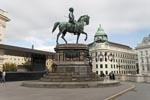
Due to their outer frame, the exhibits get again a special character. The building of the Albertina is not only from outside very elegant. Also the rooms in the interior are partly so-called splendid rooms that, with their well conserved inner decoration, are of the Habsburg times of the 18th century. On a total of 3 floors, one can walk on several thousand square metres and, from the information boards that are clearly arranged and of entertaining content, one gets an understandable insight and also an overview of the individual artists and the styles they tried to realze on their paintings. Also for us, less educated art connoisseurs, the exhibition was really interesting, so that beside the effect of recognizing individual famous artworks, there was also a kind of "aha-experience" to remember. As it is also the case in other big museums of Vienna, the diversity with which the European artists are represented beside other already well-known artists of Vienna, is specially exciting. Thus, there are artworks of Klimt, Kokoschka or Schiele beside the ones of Rembrandt, Dürer, Michelangelo or Leonardo da Vinci. Also the temporarily limited exhibitions that complement variedly the permanent exhibitions, mark some very special highlights that also attract those visitors from far way. Thus, it is easy to imagine that, for example, the exhibition of the year 2006 that focused on the topic of Pablo Picasso, was a huge success. The Albertina can be daily visited. Unfortunately, the photo equipment has to be left outside. Ceremonial Room: Part of the today's National Library at the Josefsplatz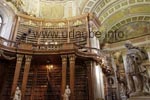
By standing on the Josefsplatz one hardly guesses that behind the walls of the National Library, there is one of themost beautiful library rooms of the world. The big baroque rooms accommodates about 200.000 books. From the ground up to the ceiling, there are books band in thick leather and kept in shelves of a height of almost 20 metres. But the actual view goes up higher than the cuppola ceiling that is decorated with frescos. The Large Ceremonial Room is described in detail in our page about the Hofburg. There are also further fascinating photographies of the ceremonial room. I would just like to emphasize again that the ceremonial room is an absolute highlight and therefore an absolute must during a visit to Vienna. One simply does not get out of the amazement by walking through this fascinating room. And even if one only takes a quarter of an hour time got the ceremonial room, this museum is the money worth. Hofburg with Sisi Museum, Silver Chamber & Imperial Appartments
Maybe, the usual museums that are more or less represented in any other bigger city, are not so interesting for the visitor of Vienna. But then in any cse, the Hofburg with the Sisi Museum and the Imperial Appartments are on program. Here, one can still clearly experience the actual function of a museum, as here, one gets an impression of the life and function of the couple of Emperors, especially of Sisi. Authentic and as drawn from life as possible, the pink-ideal-world-image of the Empress is broken here and a completely new image is communicated, that is the one of a very melancholic-depressive woman, who suffered a lot under the strict structures of the monarchy despite of all surely enjoyed benefits. But it is allowed to disagree concerning this slightly differently inscened myth that today is very well commercialised. A detailed description of the Sisi Museum is in our page about the Hofburg of Vienna. Mundane and Spiritual Treasury chamber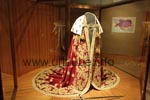
A further museum that impressed us a lot in conjunction with the visit to the Hofburg was the treasury chamber that is accommodated in the central interior, the oldest building part of the Hofburg. Since we went to school, our knowledge of history is a little rusty. This is why the agency of the facts about the Austrian-Hungarian history is the more impressive, as if a vivid image is originated by the pompous objects. Due to the proximity to the shining crowns adorned with precious stones and bright gold of the mundane monarchs and also the colour intensive ornates of the Order of the Golden Fleece, as a visitor, one almost could experience oneself as a spectator of a baptism or coronation ceremony. A detailed description of the trasury chamber is available on our page about the Hofburg. Hundertwasser HouseFriedensreich Hundertwasser (1928-2000) was actualy born in Vienna with the name of Friedrich Stowasser. By hearing his name, one immediately thinks on funny colourful worlds of colours that apparently cope without any geometrical lines. By looking at his paintings and the abundance of curls and loops, one almost feels like put back in one's childhood in which one dreamt oneself into his own colourful world while painting. Friedensreich Hundertwasser was not only limited to paintings and sculptures but realized his dreams mainly in the arquitecture. The buildings designed by himself appear to oppose the ususal geometrical standards in a playful way. 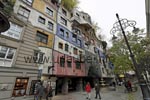
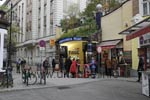
During his career, about 40 buildings were originated mainly in Austria and Germany, but also in the USA, Japan, Israel New Zealand or Switzerland. The Hundertwasser House of Vienna at the Kegelgasse 34-38 (District of Vienna Landstraße), was built in the years between 1983-1986. The name house is almost a little confusing, as actually, the building one stands in front of is a whole residential complex where still today normal people live. Unfortunately, this is also the reason why one has to remain standing in front of the building and/or only can visit the two souvenir shops. The best way to get to the Hundertwasser House is with the tram line N that goes from the city dentre into the direction of Prater Hauptallee. One has to get off at the station Hetzgasse. From there, there are only approximately 100 metres in travelling direction until one gets to the Hundertwasser House at the left side. Compared to the Kunsthaus, that is described right after this, this complex is still quite unspectacular. In order to get an impression of Hundertwassers works it is completely sufficient to get into the Kunsthaus, even if there, one has to pay a steep entrance fee for the museum. Vienna KunsthausThe Kunsthaus in the lower Weißgerberstr. 13 is also located in the 3rd municipal district Landstraße of Vienna and not far from the Hundertwasser House. We needed from there about 15 minutes walk. Already from the exterior,the Kunsthaus appers much more typiclly in the style of Hundertwasser as the Hundertwasser House. 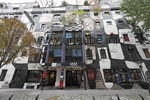
This building is about a former furniture company that, according to the plans of Hundertwasser, was rearranged to an own Hundertwasser museum in the years 1989-1991. This is on a worldwide level the only museum in which the artworks of Hundertwasser can be permanently viewed. In the interior, everything seems to be somehow waved or curved. Even during the walk over the floor furnished with bumps one almost has to be careful not to fall down. Considering the political pacific-revolutionary attitude of Friedensreich Hundertwasser and his engagement for the environment, this mass commercialization that one is normally used to in relation to a profit-oriented attitude, seems an odd thing. Also in the case of visiting the Kunsthaus it applies: first to pay n expensiove entrance fee and then to be disappointed that one is not permitted to take the camera in. 
Copyright 2007-2008: Patrick Wagner, www.tourist-guide.biz |
||